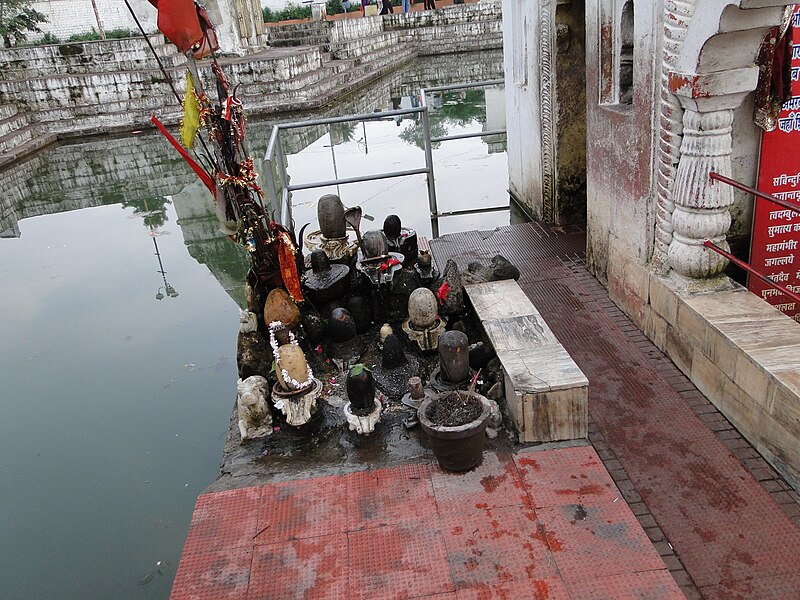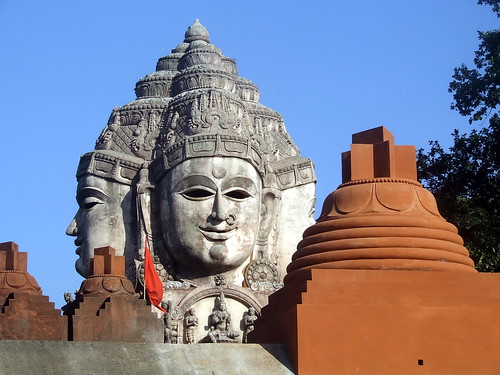Amarkantak is a pilgrim town which is situated in the Anuppur District in the state of Madhya Pradesh. This town is also known as the 'Theerthraj', meaning the king of pilgrimages. It is a meeting place of the Satpuras and Vindhyas, the two huge mountain ranges in Madhya Pradesh. Amarkantak is also the origin of the Narmada River, Johilla River and Son River. The Narmada River flows towards the western side and the Son River flows to the east. There are various holy ponds, Maikal Hills and dense forests in the region that attract adventure seekers from across the globe. Amarkantak is a Sanskrit word with much mythological significance, which gains it the prestigious sobriquet as Theertharaja. Holiness of Amarkantak is greatly associated with the holy river Narmada. Perhaps it is due to the presence of this holy river that this locale in the Vindhyans gets much popularity as a devout center As per the Holy Scriptures, River Narmada transcends all other sacred rivers with her indomitable virtue as the daughter of Lord Shiva. Legends has it that a mere glance of this beloved daughter of the destroyer God would fetch innumerable boons and the devotees strongly believe that who ever dies at Amarkantak would fetch salvation. This region has an elevation of around 1,048 meters above sea level. The Kapil Dhara Falls are located near Gaumukh, which is the source of the Narmada River. Through these falls, the Narmada River leaves Anuppur and enters the Dindori District, covering more than 20 meters A land with a vivid history, Amarkantak narrates the tales of various dynasties, right from the Pandavas to the foreign rule of the modern times. Each edifice in Amarkantak portrays diverse styles that recount the period during which these architectural grandeur were materialized. This stunning facade of Amarkantak gently adds the magnificence of this legendary spot to a great extent.
How to reach here:
By Air: The nearest airport to Amarkantak is at Jabalpur, which is 245 km away from City of Amarkantak.
By Rail: The nearest rail head to Amarkantak is Pendra Road at a distance of 17 km from the heart of the city. Anuppur at distance of 48 km from Amarkantak is also convenient for the tourists.
Best time to visit: Throughout the year.
Languages spoken: Hindi.
Places you must visit:
Narmadakund is the place of origin of river Narmada, which is surrounded by 16 major stone temples. This place covers around 6 acres of land and comprises over 23 statues of various deities. In the central position, there is an eleven corner kund, which is around 500 ft long. This eleven cornered kund is also known as Narmada Udgam or Bisha Yantram. Few of the important temples located in this complex are Narmada Temple, Lord Shiva Temple, Annapurna Temple, Guru Gorakhnath Temple, Shri Ram Janki Temple and Shri Radha Krishna Temple.


Kapil Dhara, which is also called as the Kapil Waterfall, is located just 6 km towards the north-west of the Narmadakund Temples. This waterfall is around 100 ft tall and is surrounded with dense forests and mountains. Kapil Dhara is named after the sage Kapil Muni, who is believed to have meditated at this place.On the banks on the Narmada River, there is a famous ashram, where pilgrims can worship the footprints of Lord Kapileshwar Shiva and sage Kapil Muni. Narmada River is joined by Kapila and Erandi streams to form this Kapil Waterfall.


Mai ki Bagiya (Goddess Garden) is also known as Mother's Garden. This garden is situated around 5 km from Narmadakund and covers the surrounding forests. The garden has been built in honor of the Goddess Narmada. It is a natural garden which features banana, mango, Gulbakawali, roses and fruits and flower plants.The Gulbakawali plant is known to release a lingering sweet smell. This garden also features various shrines of Hindu Gods and Goddesses, a rain-fed kund and a large number of trees.


Shri Sarvodaya Digamber Jain Temple is a new temple in Amarkantak, which is under construction until now. This temple is very similar in construction to that of the Akshardham Temple in Gujarat. There is a world's biggest ashtadhatu Jain idol of Bhagawan Adinatha in this new temple. This idol weighs around 24 tonnes and measures over 10 ft in height.The construction of this temple is a mega project with over INR20 Crore being spent on constructing the temple over an area of 4 acres. It is expected that the final temple constructed at this site will be around 144 ft in height, 424 ft in length and 111 ft in width.


Ancient Temples of Kalachuri Period were exclusively built by Kalachuri Maharaja Karnadeva (1042 - 1072 AD). These temples are located just behind the Narmadakund towards the south direction. The Kalachuri architecture is famous and includes the Pataleshwar Mahadev Temple and the Machhendranath Temple.Adi Shankaracharya, who was born in 788 AD is believed to have been consecrated on the banks of the Narmada River in Amarkantak. He is regarded as the founder of the Pataleshwar Mahadev Temple in Amarkantak, which is now known as Surajkund. These temples are largely crowded throughout the year by devotees across the globe.There is also a Keshav Narayana Temple in this complex which was built by Bhonsle ruler of Nagpur, during the 18th century.





Sonemuda is considered to be the place of origin of the Son River, which is located at a distance of around 1.5 km from the Narmadakund Temples. The Son River flows down from the Maikal Mountain in the form of waterfall that is hundreds of feet long. Tiny granules of gold can be found in this river, due to which, it is named as Son River. Sonemuda is a small pond which is now called as a kund and covers around 2 sq.km of area. There is a thin source of water emerging from this kund, which further flows through a small opening into a nallah.

Dudh Dhara Waterfalls is the second waterfall of Narmada River which is believed to have milky white water. This waterfall is situated on the western edge of the Amarkantak valley amidst thick woods and dense forests. It is a 10 ft high stream which is extremely white in color.This white colour resembles the milk which is called as dudh in Hindi. The rainy season is the best time to visit this Dudh Dhara Waterfalls, as the water in the river is at its maximum along with pleasant weather in the forests.

Shri Jwaleshwar Mahadev is mainly the temple of Lord Shiva, which is situated towards the north-east of the Narmada Temple.This temple is famous for a black Shiva lingam which is known as Jwaleshwar Mahadev. It is believed that when Lord Shiva killed the demon Tripurasura, one of the three parts of his body fell near the Narmadakund, which later on turned into the seat of Lord Shiva. The Johilla River also originates from this place and tourists can visit the nearby sunset point from this temple.



Kabir Chabutra, which ideally means the platform of saint Kabir.This is one of the sacred places, where saint Kabir achieved salvation. Pilgrims coming to this place can also see the footwear of the saint kept inside a small temple near the chabutra.This chabutra is mainly a small pond, where every morning between 9 am and 10 am, tourists can see white smoke screen spreading over the water. The Kabir Chabutra is the meeting place of three districts of Madhya Pradesh, namely Bilaspur, Anuppur and Dindori.


Sonakshi Shaktipeeth Temple is highly worshiped during the festive eve of Navratri, as it is believed that Goddess Sonakshi blesses everyone coming during this festival. This temple is located midst the Amarkantak plateau and gives a beautiful view of Son River and the nearby kund. There are around 100 steps from this temple that lead the travellers to the rim of the hillside. This hillside is famous for the scenic beauty of the Satpura hill ranges and the corresponding valley.

No comments:
Post a Comment